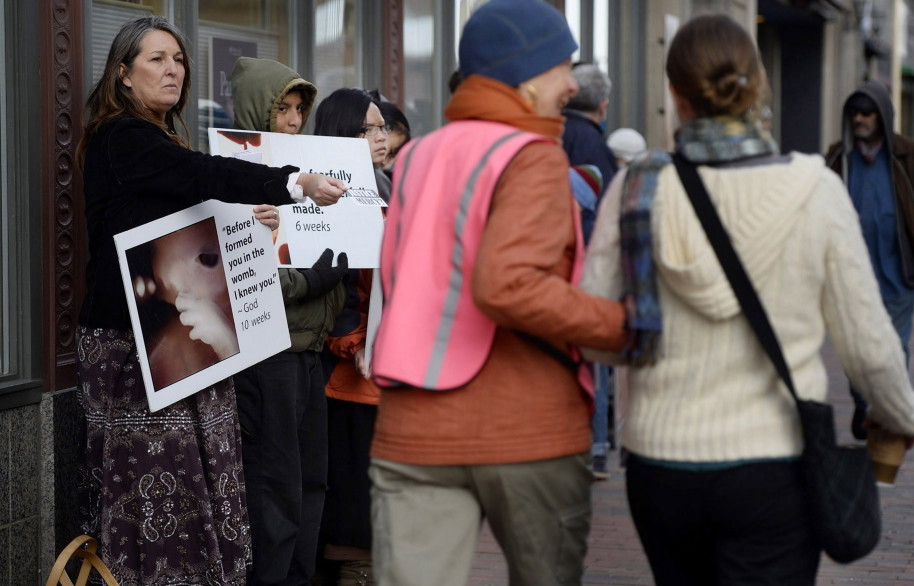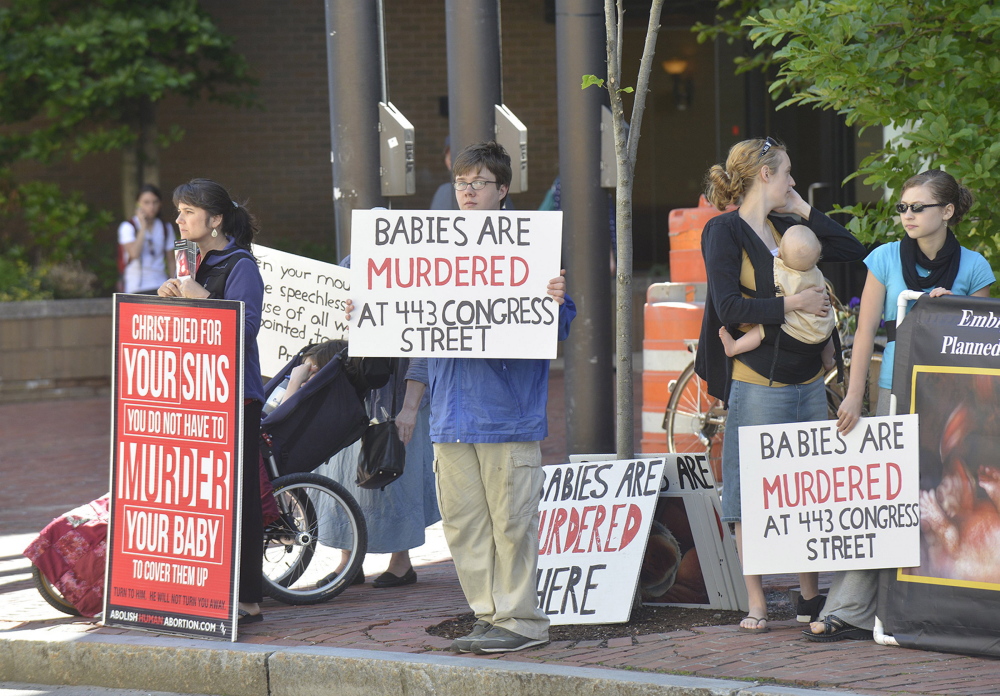In a different setting, it would be hard to tell us from them. Each group is composed of women of all ages, wearing comfortable shoes and sunglasses and carrying bottles of water on this sunny July morning.
But here on the sidewalk outside the building housing the offices of one of the three outpatient abortion providers in Maine, the divisions are stark.
They have signs that depict fetal remains and inform drivers on Congress Street that “babies are being murdered here” at Planned Parenthood in Portland. We have bright pink vests with the organization’s logo and the word “GREETER” – just like that, all in capital letters.
As volunteer escorts, our task is to get patients into the building quickly and quietly. Their goal is to keep that from happening. But no patient ever turns around, both escorts and protesters have attested. So why are we all here?
Many of them are with Pro-Life Missionaries of Maine. Their mission is to spread the word about something they passionately believe, to “proclaim the truth,” as the group’s co-foundershave said. And we’re here because they’re here.
STAYING UNDER THE RADAR
The protesters usually get to Portland around 9 and stay until around 11, so that’s our schedule, too. Regardless of the weather, they’re here every Friday. The core group – about 15 or so people, adults and children – appears all at once.
There’s no private parking lot. Patients have to use the public sidewalk to reach the clinic, passing protesters who assume that every woman walking into the building is here for an abortion, though Planned Parenthood also offers family planning and health screenings.
Five other greeters are here today with me: four regulars, plus a recently trained volunteer who’s been out there just once so far. We divide up. Half of us flank the door to the building, and the others stand at the corner of Congress and Elm – the direction from which patients usually approach – offering to walk to the door with anyone who wants an escort.
Since I, too, have just been trained, I’m asked to observe, not to escort, giving me the time to notice how the other greeters go about their task.
They catch the eye of women walking by and ask things like “Looking for help?” Not everyone does. Not everyone wants that kind of attention en route to what is, after all, a safe, legal and constitutionally protected medical procedure.
Like the woman with glasses, chin-length hair and bangs who looks about my age. She walks briskly, chin up, arm in arm with a younger woman. I’m guessing they’re mother and daughter, but I don’t know. We don’t ask patients personal questions, though we’ll make small talk during the very short time we’re with them, giving them something to focus on besides their appointment and the protesters’ sign-waving and offers of leaflets.
Or the two young women in T-shirts and sweats who nodded when we told them they were going in the wrong door but turned down our offer to walk them to the right one. They headed in on their own, one stopping to take a leaflet from a young male protester on the way.
THE RULES OF ENGAGEMENT
The first time someone accepts our assistance, it all unfolds quickly, the culmination of the tension that arises whenever a patient (or someone who might be a patient) approaches. Two volunteers, one on either side of the patient and her male companion, head down the sidewalk as protesters call out, “You don’t have to kill your baby!” and “Be a man! Stand up for your child!”
The couple being escorted don’t engage one on one with the demonstrators. There’s no face-to-face dialogue between the sidewalk counselors and the patients they’re trying to reach.
I don’t see any demonstrators follow patients to the clinic door today, though they’ve been known to do so. And nobody preaches so loudly that Planned Parenthood’s neighbors come out of the building and ask whether the escorts could help keep the noise down – though that’s happened, too.
The only activist-patient interaction I see involves one of the more vocal protesters, who makes loud references to repentance, and a skinny, spike-haired young guy, already halfway into the building. He doesn’t turn around to look at her but responds by jabbing his index fingers in the air and crying, in a mock-serious voice, “Repent! Repent!”
It’s a rare, relatively light moment at this end of the sidewalk. At the corner, I’d been able to chat quietly with other greeters. By the door, where most of the demonstrators are, it feels different.
Directly in my line of sight are massive, graphic images. A protester who’d arrived after the others, a man with a mustache and rosary beads, looks from side to side but keeps quiet. I don’t talk either, and the resulting quiet is unnerving. Standing within feet of a stranger, the temptation to say anything to break the ice as the minutes tick by is huge.
Passers-by add to the mix. A couple of people will take the protesters’ leaflets the day I’m there, but the demonstrators also hear a lot of jeers from pedestrians. The active expressions of support – honking, thumbs up, high fives, cups of coffee in the wintertime – are directed largely at the Planned Parenthood volunteers.
BRIDGING THE DIVIDE
These short interactions are welcome, but well-meaning people coming over to challenge the protesters can unintentionally cause trouble. There’s the man who stops in front of the protesters’ apparent leader and presents a disturbing hypothetical situation involving the rape of a teenage girl, who becomes pregnant by her attacker.
Carrying the pregnancy to term, this pedestrian says, would scar the young woman and disrupt her life. The demonstrator counters that in this scenario, there’s only one innocent party, whose existence shouldn’t be brought to an end just because of the circumstances under which it began.
The two of them get louder and louder as they make their respective points about whether this girl would be doomed to hell if she had an abortion. I can’t wait for him to go away so the debate will end.
Expressing opinions is usually something I encourage; I wouldn’t be able to do my job if other people kept their views to themselves. Not this time, though, and not this place.
An abortion clinic escort’s responsibility is to defuse tension, not escalate it. We don’t engage the protesters, even when they say things to us like, “I know you guys don’t believe us, but we pray for you every day. You don’t think you’re going to have to stand up in judgment, but you will.”
This is the kind of statement that proclaims a divide between the speaker and her audience: We’re going to hell, and (by implication) she’s not. I’d like to think, though, that the division between the protesters and the greeters could be bridged, even if only partway. It’s rare but not unheard of.
An escort at a clinic in Louisville, Kentucky, for example, recalls talking to a minister whose church group was outside the clinic for the first time, hoping to be able to change clients’ minds:
“We ended up agreeing that providing sex education and effective contraceptives would be a better way to reduce abortions. He stated to me, ‘We need to rethink this. This protesting on the sidewalk doesn’t help anyone. We need to reach out sooner.’ This particular group has never been back to the clinic again.”
If I were going to interact with the protesters, I’d ask them whether they agree with the minister. I suspect they wouldn’t.
They won’t settle for any measure short of the elimination of abortion. And because they won’t yield the battlefield, everybody else has to stay there, too, engaged in a conflict that doesn’t have to happen – inches away from each other but worlds apart.
Sarah Collins is the assistant editorial page editor. She can be contacted at 791-6322 or at:
scollins@pressherald.com
Copy the Story LinkSend questions/comments to the editors.




Success. Please wait for the page to reload. If the page does not reload within 5 seconds, please refresh the page.
Enter your email and password to access comments.
Hi, to comment on stories you must . This profile is in addition to your subscription and website login.
Already have a commenting profile? .
Invalid username/password.
Please check your email to confirm and complete your registration.
Only subscribers are eligible to post comments. Please subscribe or login first for digital access. Here’s why.
Use the form below to reset your password. When you've submitted your account email, we will send an email with a reset code.